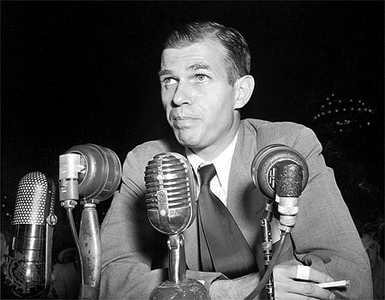Consortium News Topic: Alger Hiss and Russia-gate
Jeremy Kuzmarov argues the Cold War case has enduring relevance to American political culture and provides clues to the motives and machinations underlying the new Russophobia.
By Jeremy Kuzmarov
 In January 1950, Alger Hiss, a former State Department employee and director of the Carnegie Endowment for International Peace, was convicted of perjury and sentenced to five years in a federal penitentiary. The sentence, of which Hiss served 44 months, culminated a frenzied political trial that catapulted Richard Nixon to fame, undergirded the advent of McCarthyism and heated up the Cold War.
In January 1950, Alger Hiss, a former State Department employee and director of the Carnegie Endowment for International Peace, was convicted of perjury and sentenced to five years in a federal penitentiary. The sentence, of which Hiss served 44 months, culminated a frenzied political trial that catapulted Richard Nixon to fame, undergirded the advent of McCarthyism and heated up the Cold War.
Today, it is worth looking back at the Hiss case because it offers important clues to the motives and machinations underlying the similarly politicized Russia-gate investigations. In both cases, powerful political players appear to have attempted to deflect acts of malfeasance by falsely accusing political adversaries of treasonous behavior while igniting anti-Russia hysteria and paranoid fears of subversion that threatened war between the major nuclear powers.
Hiss was the embodiment of the liberal, New Deal establishment, which had promoted a major expansion of domestic social welfare programs. Educated at Harvard Law School, Hiss clerked for Supreme Court Justices Felix Frankfurter and Oliver Wendell Holmes, and worked for the State Department before moving on to head the Carnegie Endowment for International Peace. Supportive of President Franklin Roosevelt’s policy ofaccommodation towards the Soviets, Hiss had been present at the 1945 Yalta conference, which resulted in a spheres of influence agreement.
Hiss had also worked as a legal assistant for the Nye Committee in the 1930s, a congressional investigation into war profiteering led by Gerald Nye, a Republican senator from North Dakota. The investigation exposed high-level corruption and connections between American companies and the growth of the Nazi war machine.
For instance, it revealed how United Aircraft sold commercial airplane engines to Germany for use in Luftwaffe fighter planes. It showed how Nazi troops were armed with American guns, and how Union Banking Corporation had engaged in a cartel agreement with the German chemical conglomerate, I.G. Farben, soon to be gas maker for Holocaust gas chambers.
Because of his work on the committee, Hiss made many powerful enemies. The Republican Party at the time was looking to revive its fortunes through red- baiting tactics that would deflect attention from their anti-labor program. The Justice Department also had begun to investigate alleged treasonous activities by GOP power brokers.
Among them was Thomas McKittrick, a former agent of the Office of Strategic Services (predecessor of the CIA) who was the wartime president of the Bank for International Settlements in Basel, Switzerland. He was also an executive with Chase Manhattan Bank and a Marshall Plan administrator who allegedly conspired with his friend, the future CIA Director Allen Dulles, to move looted Nazi gold to Argentina.
Another official under DOJ investigation was Sen.Prescott Bush, a managing director of the Union Banking Corporation, which helped provide financing to Nazi industrialists in violation of the Trading with the Enemy Act during World War II. Bush was the father of President George H.W. Bush and grandfather of President George W. Bush.
Continue reading at
https://consortiumnews.com/2019/01/08/alger-hiss-and-russia-gate/



Comments
Post a Comment